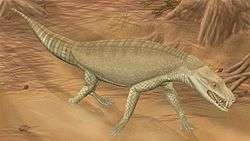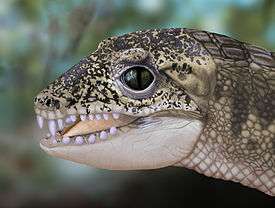Notosuchia
| Notosuchia Temporal range: Early Cretaceous – Middle Miocene, 110–11 Ma | |
|---|---|
 | |
| Mounted skeleton of the notosuchian Simosuchus clarki in the Royal Ontario Museum | |
| Scientific classification | |
| Kingdom: | Animalia |
| Phylum: | Chordata |
| Class: | Reptilia |
| Superorder: | Crocodylomorpha |
| Clade: | Metasuchia |
| Suborder: | †Notosuchia Gasparini, 1971 |
| Families | |
Notosuchia is a suborder of primarily Gondwanan mesoeucrocodylian crocodylomorphs that lived during the Cretaceous. Fossils have been found from South America, Africa, Asia, and Europe. Notosuchia was a clade of terrestrial crocodilians that evolved a range of feeding behaviours, including herbivory (Chimaerasuchus), omnivory (Simosuchus), and terrestrial hypercarnivory (Baurusuchus). It included many members with highly derived traits unusual for crocodylomorphs, including mammal-like teeth, flexible bands of shield-like body armor similar to those of armadillos (Armadillosuchus), and possibly fleshy cheeks and pig-like snouts (Notosuchus). The suborder was first named in 1971 by Zulma Gasparini and has since undergone many phylogenetic revisions.[1]
Description
Notosuchians were generally small, with slender bodies and erect limbs. The most distinctive characteristics are usually seen in the skull. Notosuchian skulls are generally short and deep. While most are relatively narrow, some are very broad. Simosuchus has a broadened skull and jaw that resembles a pug, while Anatosuchus has a broad, flat snout like that of a duck.
The teeth vary greatly between different genera. Many have heterodont dentitions that vary in shape across the jaw. Often, there are large canine-like teeth protruding from the front of the mouth and broader molar-like teeth in the back. Some genera, such as Yacarerani and Pakasuchus, have extremely mammal-like teeth. Their molars are complex and multicuspid, and are able to occlude or fit with one another. Some forms such as Malawisuchus had jaw joints that enabled them to move the jaw back and forth in a shearing motion rather than just up and down.
A derived group of notosuchians, the baurusuchids, differ considerably from other forms. They are very large in comparison to other notosuchians and are exclusively carnivorous. Baurusuchids have deep skulls and prominent canine-like teeth.
Classification
Taxonomy
Genera
The evolutionary interrelationships of Notosuchia are in flux, but the following genera are generally considered notosuchians:
| Genus | Age | Location | Unit | Notes | Images |
|---|---|---|---|---|---|
| Turonian - Santonian |
A carnivore with a very short, high skull and large eye sockets |
| |||
| Aptian - Albian |
Tegama Group |
A small notosuchian under 1 metre (3.3 ft) long with a duck-like snout |
| ||
| Albian - Maastrichtian |
Maevarano Formation |
Five species are known, the most of any notosuchian |
 | ||
| Turonian - Santonian | A sphagesaurid with armadillo-like armor shields. |  | |||
| Turonian |
A large hypercarnivore 3.5 to 4 metres (11 to 13 ft) in length |
| |||
| Turonian – Santonian | |||||
| Turonian – Santonian | |||||
| Albian | |||||
| Aptian - Albian |
Wulong Formation |
The first notosuchian found with heterodont teeth, thought to be a herbivore |
|||
| Santonian | | ||||
| Coniacian – Santonian |
Bajo de la Carpa Formation | ||||
| Cenomanian | Bahariya formation | ||||
| Malawisuchus | Early Cretaceous |
A possible burrower that could move its jaw back and forth while eating | |||
| Campanian - Maastrichtian | | ||||
| Turonian - Santonian |  | ||||
| Coniacian - Santonian |
A notosuchian that may have had a pig-like snout |
| |||
| Albian | A notosuchian with very complex, mammal-like heterodont teeth. |  | |||
| Campanian – Maastrichtian |
Vale do Rio do Peixe Formation |
 | |||
| Maastrichtian | A broad-snouted omnivore with clove-shaped teeth |  | |||
| Late Cretaceous |
An omnivorous notosuchian |
||||
| Turonian – Santonian |  | ||||
| Santonian - Campanian | | ||||
| Santonian | |||||
| Turonian - Santonian | A notosuchian with rabbit-like incisors found in association with a probable nest |  | |||
Phylogeny
| |||||||||||||||||||||||||||||||||||||||||||||||||||||||||||||||||||
| |||||||||||||||||||||||||||||||||||||||||||||||||||||||||||||||||||
| |||||||||||||||||||||||||||||||||||||||||||||||||||||||||||||||||||
The clade Notosuchia has undergone many recent phylogenetic revisions. In 2000, Notosuchia was proposed to be one of two groups within the clade Ziphosuchia, the other being Sebecosuchia, which included deep snouted forms such as baurusuchids and sebecids.[2] The definition of Notosuchia by Sereno et al. (2001) is similar to that of Ziphosuchia as it includes within it Sebecosuchia. Pol (2003) also includes Sebecosuchia within Notosuchia.[3] More recently, a phylogenetic analysis by Larsson and Sues (2007) resulted in the naming of a new clade, Sebecia, to include sebecids and peirosaurids.[4] Baurusuchidae was considered to be polyphyletic in this study, with Pabwehshi being a basal member of Sebecia and Baurusuchus being the sister taxon to the clade containing Neosuchia and Sebecia. Thus, Sebecosuchia was no longer within Notosuchia and not considered to be a true clade, while Notosuchia was found to be a basal clade of Metasuchia.
The following cladogram simplified after the most comprehensive analysis of notosuchians to date, presented by Pol et al. in 2014. It is based mainly on the data matrix published by Pol et al. (2012) which is itself a modified version of previous analyses. Thirty-one additional characters were added from other comprehensive analyses of notosuchians, e.g. Turner and Sertich (2010), Andrade et al. (2011), Montefeltro et al. (2011), Larsson and Sues (2007), and Novas et al. (2009), and 34 characters were noval, resulting in a matrix that includes 109 crocodyliforms and outgroup taxa which are scored based on 412 morphological traits.[5]
| Notosuchia |
| |||||||||||||||||||||||||||||||||||||||||||||||||||||||||||||||||||||||||||||||||||||||||||||||||||||||||||||||||||||||||||||||||||||||||||||||||||||||||||||||||||||||||||||||||||||||||||||||||||||||||||||||||||||||||||||||||||||||||||||||||||||||||||||||||||||||||||||||||||||||||||||||||||||||||
| |
References
- ↑ Gasparini, Z. (1971). "Los Notosuchia del Cretácico de América del Sur como un nuevo Infraorden de los Mesosuchia (Crocodilia)". Ameghiniana 8: 83–103.
- 1 2 Ortega, F. Z.; Buscalioni, A. D.; Calvo, J. O. (2000). "A new species of Araripesuchus (Crocodylomorpha, Mesoeucrocodylia) from the Lower Cretaceous of Patagonia (Argentina)". Journal of Vertebrate Paleontology 20 (1): 57–76. doi:10.1671/0272-4634(2000)020[0057:ANSOAC]2.0.CO;2.
- 1 2 Pol, D. (2003). "New Remains of Sphagesaurus huenei (Crocodylomorpha: Mesoeucrocodylia) from the Late Cretaceous of Brazil". Journal of Vertebrate Paleontology 23 (4): 817–831. doi:10.1671/A1015-7.
- 1 2 Larsson, H. C. E.; Sues, H.-D. (2007). "Cranial osteology and phylogenetic relationships of Hamadasuchus rebouli (Crocodyliformes: Mesoeucrocodylia) from the Cretaceous of Morocco". Zoological Journal of the Linnean Society 149 (4): 533–567. doi:10.1111/j.1096-3642.2007.00271.x.
- ↑ Pol, D.; Nascimento, P. M.; Carvalho, A. B.; Riccomini, C.; Pires-Domingues, R. A.; Zaher, H. (2014). "A New Notosuchian from the Late Cretaceous of Brazil and the Phylogeny of Advanced Notosuchians". PLoS ONE 9 (4): e93105. doi:10.1371/journal.pone.0093105. PMC 3973723. PMID 24695105.
| ||||||||||||||||||||||||||
| ||||||||||||||||||||||||||||||||||||||||||||||||||||||||||||||||||||||||||||||||||||||||||||||||||||||||||||||||||||||||||||||||||||||||||
